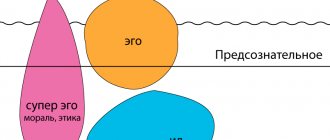Relationship
“Damn, David Blaine! How did he do this?!” — I thought about a simple street scammer who showed me real street magic. Although this was not magic at all, but just a manipulation of my consciousness, as a result of which I was left without the 1,000 rubles I had earned an hour ago. Everything happened so quickly that I spent the whole day remembering and analyzing all his actions, which were based on the simplest NLP techniques. Of course, I knew about neurolinguistic programming of the brain, but only to fall for the bait myself. It’s even funny to remember this! Therefore, I would like to talk more about NLP and give some cool techniques that will allow, so to speak, to influence people in the situation we need.
Change of submodalities
Submodalities are those elements that make up a holistic picture of our perception of the surrounding reality. With the help of them our attitude towards everything is encoded. The technique of changing submodalities allows us to change our attitude towards something, and we can influence not only the strength of the experiences we experience, but also transform their assessment and subsequent sensations. In addition, this technique is also suitable for changing the assessment of some situation that happened a long time ago, developing motivation, changing attitudes towards another person, etc.
As a rule, the scheme of this technique is always approximately the same: you need to take a situation (person) towards which you need to change your attitude, and a situation (person) in relation to which you experience, on the contrary, positive emotions. Then you need to find several differences between these situations (people) and their submodalities, and replace the submodalities of the first situation with the submodalities of the second. After this, a check is made: if the situation has changed in the desired direction, then the replacement was successful; if not, then you need to return to the previous step and work it out again.
You can learn more about the technique of changing submodalities here.
2
Ways to avoid manipulation
Specialists in this field take advantage of a person’s temporary weaknesses (chronic fatigue, lack of attention, lack of motivation, subconscious fears, tension, neuropsychic exhaustion, complexes).
Fraudsters can easily find out information about your moral and physical condition from social networks. This is the best way to virtually study a person’s subconscious and begin to manipulate it. To protect yourself, it is not at all necessary to learn a lot of techniques and techniques.
It is enough to comprehend your inner world, strengths and weaknesses, feel your personal “I”, and only then will you program your own thoughts, set the tone for events and create a life scenario.
Model of correct goal setting “SMARTEF”
A huge role in the process of achieving goals is played by the ability to correctly formulate and determine the desired result. Simply put, in order to change anything in life, you need to have a clear idea of what you specifically want. It is the SMARTEF technique that helps to determine and formulate the result properly. Compliance of a goal with SMARTEF criteria greatly increases the likelihood of its implementation. The goal should be:
- Specific (you must take into account all the details);
- Measurable (you must be clearly aware of all the indicators of the moment when the goal is achieved);
- Attractive (the goal must correspond to your beliefs and values, motivate you);
- Realistic (you must know for sure that the goal is achievable and what you will need to achieve it);
- Time-bound (you must clearly set a time frame for achieving the goal);
- Environmental friendliness (you must consider your goal in global terms, and also realize the secondary benefits of achieving/not achieving it);
- Positive wording in the present tense (when setting a goal, you must take into account special wording parameters).
We have already touched on the SMARTEF technique in our lesson “Anchoring, Performance and State Management”. If you wish, you can return to it or study the method in more detail here.
3
Possible results of the technique
The main result of studying how NLP works will be a significant improvement in the quality of your own life. Building your thinking allows you to concentrate on useful details. By moving in a given direction, without wasting energy and time avoiding undesirable aspects, you can soon arrange your life so that everything in it brings only pleasure.
How to manipulate people - can this be learned, methods of influence
Increasing the level of personal satisfaction with life is one of the most common goals pursued by society. Learning to let reality pass through oneself in such a way that inevitable negative aspects do not become an obstacle to making one’s own plans is one of the most valuable abilities available to those who study the techniques.
Interesting. Only hypnosis can influence people like NLP, but it cannot be invisible, unlike latent manipulation.
Walt Disney's Creative Strategy
This technique is based on the many years of experience of the American animator and film director Walt Disney in the fields of business and creativity. The essence of his strategy is the ability to approach any issue from three different positions: a dreamer, a realist and a critic. This approach itself was called “imagining” by the author. Each of the three components makes its contribution to the search for an effective solution to any issue.
The main function of the dreamer manifests itself at the initial stage, when new goals and ideas are just being formed, and is focused on the future. The dreamer must help the person see how all the components of his plan fit together. The function of a realist is expressed in the search for tools suitable for the implementation of the intended plan, so that an abstract idea can take shape into something concrete. A realist helps a person move from thought process to action. A critic, in turn, is needed to evaluate the emerging idea or planned plan to achieve a goal from a critical perspective. The critic is called upon to help a person find weak points in his plan, to try to identify potential problems or points that might have been missed. The critic also draws a person’s attention to such things as the environmental friendliness of the plan, its realism, secondary benefits, etc.
Approaching any task using Walt Disney's creative strategy greatly increases a person's effectiveness and personal productivity. You can learn more about this strategy here.
4
Areas of application of the techniques
The effectiveness of this kind of psychological techniques began to be used in all kinds of branches of science. The following main areas are identified:
- Sales. Most of them are based on similar methods (from drawing up a plan to the actual implementation).
- Negotiation. The psychological part is an essential component of what is happening. It is important to operate with accurate and compelling information, to capture the client’s behavior in order to manipulate him.
- Communication. Manipulation is one of the main elements in building invisible control.
- Public speaking. Voice production, appropriate gestures, laconic phrases with a strong message, controlled ease and spontaneity are achieved by certain methods.
- Interpersonal relationships. If you know the laws of NLP, it will be easier to understand them and find common ground.
- Marketing. It is based on NPL.
- Cinema. Actors often use Ericksonian hypnosis.
- Recruitment. Using metaprogrammatic personas (basic filters for how someone is perceived) is an effective method for recruiting employees.
- Modeling. This process underlies the manipulation technique.
- Self-development. Targeting yourself, finding motivation to achieve heights in any area of life.
Working with logical levels
According to the results of research by one of the first developers of NLP, Robert Dilts, there are several levels of a person’s perception of reality and how he lives it. They are all parallel to each other and closely interconnected. It is very useful for a person to become aware of what is happening at all these levels, because it affects any aspect of life: decision-making, relationship formation, sensations and well-being, and even current events. It is also important to know that logical levels are subject to a specific structure. Firstly, the Higher levels cannot exist without the Lower ones, because is realized through them, and secondly, the Lower levels depend on the Higher ones and obey them.
Usually a person forms his goals and realizes problems at the Lower levels and therefore one can begin to work with them at these levels. But, taking into account the above-mentioned patterns, goals and problems should be worked out at the Highest levels, because The best way to find a solution to any problem is to find its roots and deal with them directly.
Working with logical levels is an extremely effective technique for interacting with your goals and inducing life changes. Absolutely everything that a person desires must be in agreement with his Higher levels, i.e. consistent with beliefs, values and worldview. Working through problems at the Highest levels helps to identify the necessary resources and increase their energy potential.
You can find out more information about working with logical levels at this link, and here you can listen to an audiobook on this topic.
5
What is NLP?
NLP (neuro-linguistic programming) is a popular area of practical psychology that was founded in the 60s of the 20th century. The founders of NLP are linguistics professor John Grinder and student Richard Bandler from the University of California. For a long time they studied many of the works of famous psychotherapists, conducted various seminars and communicated with their patients. As a result, they managed to separate neurolinguistic programming from psychology and gelstatt therapy.
NLP is a complex of psychotechniques, as well as verbal and non-verbal techniques that are capable of “ introducing ” certain information into a person’s brain in order to change his thinking and behavior. Neurolinguistic programming is based on working with the human consciousness.
Now I’ll tell you what NLP is capable of. Believe me, very, very much!
NLP allows a person to completely control himself: his body, physical condition and health, his thoughts, emotions, feelings, fears and prejudices. A person is able to regulate his weight, blood pressure, body temperature, heartbeat, and general well-being. With the help of NLP techniques, you can induce a feeling of joy in yourself and easily get rid of any negative experiences.
NLP allows you to manipulate other people. Fall in love with yourself, fall out of love. To win over anyone, to come to an agreement even with the most intractable person. Get the answer you need. Successfully negotiate, gain sympathy from the boss, and so on.
NLP gives a new perspective on problems, allowing you not only to solve them in the easiest and fastest way, but also to derive maximum benefit from it.
NLP helps you achieve your goals in life faster, which is very important if you are developing yourself as an individual. And it doesn’t matter whether you want to get rich, buy real estate abroad, get married or lose weight. Any goal becomes closer and more accessible if you use NLP techniques.
I think you've already developed an interest in neuro-linguistic programming! And even if you don’t study psychology, you can still find a solution to apply it to your personal issue that has been tormenting you for so long or a problem that you would like to solve once and for all.
"Swing"
The presented technique serves to change, within a short time, a person’s destructive type of response to something and replace it with a more constructive one. But the result of this technique is not only a change in the type of reaction, but also the establishment of a positive and productive self-image in a person. “The Swing” can be used in many areas of life, from eliminating bad habits to correcting problematic behavior.
The structure of the “Swing” technique is as follows: first, the context is determined, i.e. a situation to which one would like to change the reaction. Then you need to identify the triggering factors, i.e. those factors that cause the desire to react in a habitual way. This point is the most important, because often the person may not even be aware of it. Determination of trigger factors also occurs according to a certain method. After this, you need to create an image of the state you want to achieve. Most often this is done using the third perceptual position. The next stage is the “swing” that needs to be performed. It means a very quick replacement of one picture with another (an unwanted image with a desirable one). After the “swing” is completed, you need to check the new state and adjust to the future.
The Swing technique requires more detailed study (this can be done here) and training.
6
Top 7 most effective manipulation techniques
- Joining. When we notice a stranger, the brain intuitively turns on a defensive reaction. It is difficult to suggest something to such a person, so try to copy your interlocutor. Make the timbre of your voice as similar as possible, watch your gestures, gait and even breathing. This will help the person become relaxed in communicating with you.
- Rapport - establishing trust between the communicator and the client, creating a safe space. In a state of common jokes, an unobtrusive atmosphere and pleasant chatter, the threshold of criticism towards each other decreases, and sympathy increases.
- Rule of 3 yeses. After introducing it into the report, you can send the object of manipulation into a light trance. To do this, consistently ask questions to which he will say “yes” or express agreement. The last question is the key one; due to inertia, it is difficult to refuse.
- Template break. This is a violation of typical actions, refined to the point of automatism, by a sharp, unexpected movement or word. Breaking the pattern is quite easy. The period of confusion lasts on average 30 seconds, but it all depends on your skill and sensitivity of the controlled one.
- Switching attention. This technique is often used by both illusionists and scammers.
- Maintaining. With him, it is important not to lose rapport and maintain trust in tandem.
- Reframing. A useful technique used as a way to reassess what is happening in life.
New behavior generator
This technique, similar to the previous one, is designed to help a person change automatic reactions to manifestations of external reality, thereby saving him from many unnecessary problems. Thanks to it, a person’s self-confidence increases, reactions change and positive changes occur in life.
Successful application of this technique involves going through several stages. First you need to identify the situation that needs to be worked out and live it, imagining it in your mind in the smallest detail. Next, you need to imagine the same situation in the form of a film made about you, and feel the emotions that it evokes. After this, you need to imagine yourself as a cinema operator who puts a film on the projector with a film about you for himself, sitting in the hall. Then you need to imagine yourself as a director and realize the possibility of changing the script; come up with several new options and choose the most suitable one.
The new stage implies that you are again a cinema operator, putting on a new film for yourself, sitting in the cinema hall. Then you imagine yourself sitting in the hall and watching a new film with your participation. As a result, you must imagine yourself as the hero of a new film and live a new situation, imagining it in all details in your imagination and realizing your emotions. It is important that you are satisfied with the new result. If it does not satisfy you, then you should return to the previous points and work through them again.
The result should be the emergence of a new response pattern, but one that will be beneficial. You need to consolidate it by replaying the situation several times, using new reactions. You can learn more about how to do all this on this page.
7
Verbal psychotechnicians
This type of exercise involves the use of the voice. They are effective both in combination and individually. Replace orders, use polite requests. Instead of issuing a command (for example, “Bring me a bag”), ask the person about the possibility of doing so (“Excuse me, could you give me a bag?”).
The next option is turns: “Do you realize that your well-being is improving?”, “Do you understand that this product is the most convenient to use?”, “Do you know what is being shown in cinemas today?”, “You notice how it rises mood after taking these vitamins?
Replies of this type become traps for our brain, they are aimed at searching for sensations and impulses. As long as we focus on them, other phrases automatically enter our consciousness without criticism.
A popular speech strategy is the use of truisms - the use of banal statements, generally accepted facts with which it is impossible to disagree.
Six-Step Reframing
Many of us are familiar with the situation when certain problems are not solved for a very, very long time, and we cannot understand the reason for this. The fact is that this is hindered by our own subconscious, which for some reason seems to think that the way it is now is best. The six-step reframing technique is very suitable for changing the mood of your subconscious. It is based on a special meditative state, in which the subconscious is most receptive to incoming information, whereas in the normal state its access is blocked by various subpersonalities (see here).
The six-step reframing framework is quite simple.
First step. You need to lie on the floor and relax, alternately tensing and relaxing all the muscles of the body, after which you just lie there for about five minutes, focusing on breathing.
Second step. Visualization of a large white screen.
Third step. Once the screen is presented, you need to ask your subconscious mind whether it is ready to cooperate. The answer should appear on the screen.
Fourth step. If the answer is yes, then you can ask the subconscious any questions, the form of which should imply simple answers (yes/no).
Fifth step. In the process of interacting with the subconscious, you need to find out from it what benefits it derives from the current problematic situation, and turn to the creative component of your personality with a request to find a more suitable way to satisfy this need.
Sixth step. You should relax, allowing the subconscious to process the information, slowly count from one to ten and stand up. Reframing is over.
The use of six-step reframing helps to effectively solve many problems. It is best, of course, to be under hypnosis while using it, for which you can seek the services of a specialist. But you can use it yourself. You can study the features of this technique in more detail here. You can also watch an interesting video on this topic.
8
Common Programming Techniques
Some methods and techniques can be mastered after long practice, some are used by people in everyday life. They are equivalent in effectiveness. The psyche of any individual consists of identical components, this explains the high productivity of the methods.
- Deliberate questioning. Have you noticed the situation that sometimes the interlocutor, supposedly for better assimilation, asks again twice, initially repeating you, but then introducing a different meaning into the context? He wants to control your actions. How to avoid these troubles? Listen to what you hear. Did you notice the catch? Don't back down, even if the person moves on to another topic or is in a hurry. Ask again, don’t be afraid to clarify.
- Topic jumping. In this situation, the manipulator tries not to dwell on what was said, but to move on to new information. What does this give? Previously voiced information immediately passes into the subconscious, because the conscious mind did not have time to analyze it. How to proceed? Imagine that you are a confused schoolboy who constantly questions the teacher in an attempt to understand him. Then you will take the lead in the conversation, disarming your interlocutor.
- False inattention. Is your interlocutor constantly distracted and expressing some kind of indifference? You are saying more and more unnecessary things. Without noticing this, you give the manipulator a chance to find out hidden information. In this case, carefully follow what is said and do not weaken your personal volitional control.
- An invented weakness. Have you noticed that when communicating with a defenseless person, you want to be gentle and patient, because of the feeling of pity evoked towards him? This is another trick of an insidious manipulator with an invented weakness. You need to be vigilant and try to control what is happening.
- False love. Girls usually fall for this kind of manipulation. Having captured the heart with his attractive energy, the young man also gains control over the girl’s consciousness. Then the whole course of events depends on him. It is important to remember to have clarity of mind and common sense.
- Uncontrollable anger. The manipulator suddenly shows some kind of unreasonable rage. Then the person at whom this furious pressure is directed is subconsciously ready to make any concessions. To avoid this, show indifference to your interlocutor or fake an angry situation.
- An unexpected secret. The manipulator, after a short dialogue, suddenly begins to talk about a serious and frank matter. Makes it clear to the interlocutor that he trusts in order to provoke a reaction from him. This occurs as a result of a weakening of the mental barrier, a decrease in the vigilance of the object of manipulation.
- Irony. The interlocutor is trying to “irritate you” with a mocking tone. He specifically questions the words you have said, wants to achieve a state of anger in which critical thinking decreases, a person is able to unconsciously reveal previously hidden information. A good defense would be inertia towards the manipulator. This will mislead him.
- Sudden counterargument. The goal of the manipulator is to control and then make you feel guilty before him. He draws up a supposed logical chain of events based on your previously spoken words, but arranged to his advantage. A person puts pressure on internally weak, self-critical people, lowering the barrier of their protective psyche with words of manipulation.
- Accusation in theory. The manipulator proves the position that your expressions are empty remarks that have no practical application. He tries to humiliate his opponent, thereby forcing him to prove the opposite. In this situation, you cannot pay attention to unmotivated words. The main thing is your faith in the power of your own mind.
Changing your personal history
The technique of changing personal history is used, as a rule, in cases where the behavior that needs to be changed is associated with some events that took place in the past, and is based on connections between the present and the past. Its use allows you to get rid of unnecessary and limiting beliefs, stereotypes, habits, attitudes, methods of response, etc.
The essence of the method is as follows. You need to identify a problem situation or an undesirable state and set an anchor on it. The established anchor must be used to guide the person (or oneself) to the very moment when the problematic situation or experience first appeared, and whenever they are discovered, the context of what happened must be taken into account. After several (4-5) similar situations or experiences have been found, you need to lower the anchor and return to the very first situation, determine the resources that were required to overcome it, and find the triggering factors. Next, you need to find access to the found resource and anchor it, return to the earlier situation and change its perception, using an existing resource (collapsing anchors are great for this.
After all that has been done, you need to dissociate from new experiences and evaluate the result obtained. If it does not meet the requirements, then you should return to the previous stage of identifying resources and work it out again. Then you need to consolidate the result and carry out an environmental check and synchronize with the future.
You can learn more about how all this is done here.
9
Additional materials
It is impossible to describe all possible models and techniques of neurolinguistic programming within one online course. This is also due to the fact that this research area continues to develop, modeling new psychological and linguistic techniques. Many of these techniques are quite specific, so they will not be of interest to all 4brain readers. To make it easier for you to find the information you need, we decided to provide links to additional materials (books, videos, articles) that are not included in our course.
Books
You can find many NLP textbooks in stores, but often these books contain little useful information. To help you better navigate the literature on neurolinguistic programming, we have selected a list of the most popular and proven books. It included:
- Tricks of the tongue. Robert Dilts
- From frogs to princes. John Grinder
- NLP Practitioner: Complete Certification Course. NLP magic textbook. Bodenhamer B., Hall M.
- The art of persuasion. Richard Bandler
- 77 best NLP techniques. Michael Hall
- And some others.
Video
Due to the fact that many NLP techniques represent specific speech techniques and behaviors, it is difficult to learn all of this just by reading a text description. An important component of training is visual examples of people who have already mastered the required technique, as well as master classes and lectures by leading experts. We also tried to include videos with such examples and presentations in our training and additional materials.
Other materials
In addition, pay attention to our other online trainings that complement NLP knowledge:
- Training in public speaking and writing will help you better master your oral and written language skills.
- A course of lessons on human psychology will introduce you to the basic concepts of psychology: personality, motivation, society, development.
- In leadership classes, you will learn about the qualities of real leaders and management styles.
And finally, some more useful information.
Quick treatment for phobias
The rapid treatment technique for phobias is used in NLP to neutralize anchors to any strong experiences, i.e. rid a person of phobias: xenophobia, agoraphobia, nyctophobia, photophobia, claustrophobia and many others. The result of successful application of this technique is the liberation of a person from fears, the release of energy and the emergence of many new opportunities.
The process of implementing the technique for quickly treating phobias consists of several steps:
- You need to gain access to a positive state and anchor it, creating a powerful resource anchor. Moreover, it is best if the anchor is kinesthetic.
- It is necessary to conduct a dissociative analysis of experiences, imagining yourself before being in a negative state (black and white picture) and after being in it (color picture).
- You need to look at yourself from the outside, as if sitting behind yourself in a movie theater.
- You need to quickly watch a black and white film, consisting of the first picture, the event itself and ending with a color picture.
- Then you need to watch the entire black and white film, but starting from the second color picture and ending with the first, and during the transition to the first picture you need to move to the second degree of dissociation (look at yourself watching the film). After moving to the first picture, the film should end immediately.
- You need to think about what was the source of the phobia and note changes in your physical condition.
- You need to project the negative situation into the future by imagining interaction with the source of the phobia and thinking about new response options. It is important to clearly define indicators of a feeling of safety or pointers to careful behavior.
You can learn more about the technique for quickly treating phobias on this page.
10
Mechanisms of perception of manipulation
Long before the discovery of the principles of human programming, it was noted that people differ in their types of perception into conditioned categories.
- Visuals - gain access to surrounding information mainly through visual images;
- Auditory learners - understand the world better through sounds;
- Kinesthetics - perceive the world through sensations and touches;
- Digitals are people-computers for whom the most important thing is internal dialogue and thinking.
After several techniques, the manipulator will determine the type that has the highest priority for you and will adjust the techniques to pin you down.
Reimprinting
The name of this technique comes from the word “imprint”, meaning “imprinting”, i.e. any experience or set of experiences as a result of which a person developed certain beliefs. Often imprint situations are dead ends and cause a person to feel meaningless, hopeless, hopeless, etc. The point of imprinting is to find the resources necessary to change ingrained beliefs and update established behavioral patterns.
The use of the reimprinting technique is based, first of all, on identifying the symptoms of the imprint, which involves focusing on the very first appearance of any experiences associated with it and the beliefs that have arisen. After this, you need to mentally transport yourself to the moment that preceded the emergence of the imprint, return to the present state and look at the imprint from the position that preceded it. The next stage is the search for positive intentions or secondary benefits that are hidden behind the established reactions and symptoms of the imprint and some other equally important components that require more detailed and scrupulous study.
The features of reimprinting and the procedure for its implementation can be found here.
11
Benefits and harms
Before applying the NLP method, you need to carefully familiarize yourself with the basics of this branch of psychology. Some believe that this is a way to zombify a person and deprive him of his will. Neurolinguistic programming techniques are officially recognized in many countries: France, Germany, Austria and Sweden. Psychotherapists, trainers and coaches include NLP in their classes and trainings to teach people to achieve their goals, solve problems and not be afraid to change their lives.
Any inept psychological interventions can harm a person’s health. The NLP technique is contraindicated for people with serious mental disorders and developmental disabilities. It can also cause harm to children whose psyche is still developing.
Reassessment of the past
The technique of re-evaluating the past helps to change the assessment of any event that took place in a person’s past. It is very effective because... with its help you can influence the assessment of the troubles that have occurred and the beliefs associated with them, change relationships with specific people, and even transform aspects of the perception of childhood. A brief algorithm of necessary actions includes the following:
- It is necessary to determine the period of time that requires change and elaboration. It can be associated with a person, place, time, etc. conditions.
- We need to create a powerful resource anchor. It is best if it is kinesthetic.
- It is necessary to imagine the time period in question in the form of a straight line located on the floor, determine the most significant moments of this period, name them and mark them on the line, observing the real sequence.
- It is necessary to divide all noted situations into positive and negative. Then, walking along the line, you should re-experience positive situations anew, and imagine negative ones dissociated, i.e. watching yourself from the outside.
- When considering negative situations in a dissociated way, you can use the resource anchor created at the beginning. Sometimes this allows you to look even at negative events from a different angle and see the positive aspects in them.
- It is necessary to conduct an ecological check of the new perception of past events and, if the result does not satisfy all the requirements, go back and work through the previous points again.
- It is necessary to synchronize with the future, projecting the achieved result onto situations that may occur.
The technique of revaluing the past is discussed in more detail here.
12
Nonverbal psychotechnics
We receive voluntary consent or a desired reaction by signs (postures, gestures, facial expressions, territorial location). Their body sends them to the subconscious, after which a reaction occurs. You need to win over your friend by taking a relaxed position at the beginning of the conversation.
Don't cross your legs or arms. Avoid stiff gestures - they can easily be perceived as an impulse of tension and insincerity. These include twisting something in your hands (pencil or notebook), averting your eyes or twitching your hair.
Timeline selection
The presented technique has proven itself to be a reliable tool for resolving those situations when there is a choice of something, but a person does not know what is the best thing to do. In addition, the timeline choice technique can be used to predict the long-term consequences of each of the possible options.
The first thing you need to do to successfully use this technique is to realize that you have a choice: you need to clearly define for yourself what options exist. Next, you need to speculate on how long the choice you make can have an impact on, and mentally draw a line on the floor reflecting this period. Then you need to set a deadline for yourself by which you need to make a choice; Between this date and the present day, you need to determine the most optimal time for selection. Then you should mentally move into the future and try to note the events that your choice may cause; Give these events an assessment by looking at them from the outside. You can also resort to integration to walk the intended route, as if observing from the outside at the people who have already passed it. At the end of all this, you need to return to the starting point and think about whether there is an opportunity to somehow improve the route or create a new, more efficient one. Evaluate your choices: What did you learn from traveling along the timeline? The number of positive aspects will indicate to you the right choice.
The time line selection technique is discussed in detail here.
13
Three different aspects of any field of knowledge.
We can use a field of knowledge and research such as physics as a template for understanding various aspects of NLP. Physics can be divided into three different levels:
1. Practical technology , dedicated to the specific applications of science in the real world, from building bridges, cell phones and spacecraft, to determining the properties of atoms, viruses and life in general - including everything in between. This technology takes the form of a recipe, telling us what to do in order to achieve certain goals or results, just as a recipe for making a cake is a reliable way to get that cake. As Paul Valery said, “The term science should not be used to describe anything other than a collection of those recipes that always work successfully. Everything else is literature.”
2. Methodology or theory, a set of concepts that guides the further development and use of this technology. The methodology includes all the ideas we have about the technology and how we think they are related. As Einstein said, “Nothing is as practical as a good theory.”
The basic principle - defined by many psychological experiments - is that we cannot know objective reality, we only have a “map” of reality formed by our senses. This principle was formulated by Alfred Korzybski in the book Science and Mental Health: “The map is not the territory.” There will always be gaps, errors and omissions in our map. A map can be very useful and practical, but it will never fully correspond to the reality it is trying to describe. If it were completely consistent, it would be so complete, complex and confusing that it would no longer be useful as a map.
3. Epistemology, how we know what we know; the way we decide what evidence to use to determine truth when we test both technology and methodology. At the heart of the epistemology of physics is scientific experimentation: testing our predictions and results in as many ways as we can, using as many controls as we can manage. This verification is what distinguishes science from guesswork, revelation, and prejudice.
Belief Structure
Beliefs can be divided into two groups:
“rules of life” - how it works;
“categorization” - what is what.
Belief
the reason tells what needs to be done to achieve the value;
about the consequence - what will happen after achieving the value;
about criteria - what must happen so that it can be decided that the value is satisfied;
definition - what this value is;
category assignment - which category the object belongs to.











